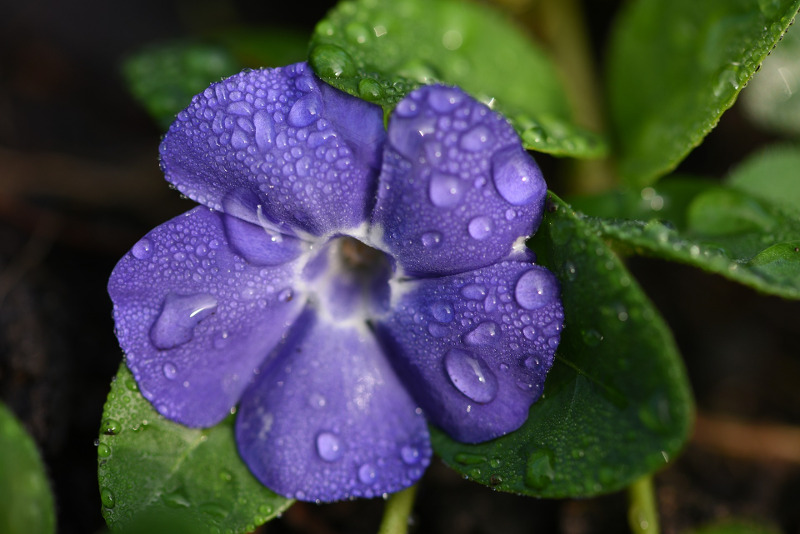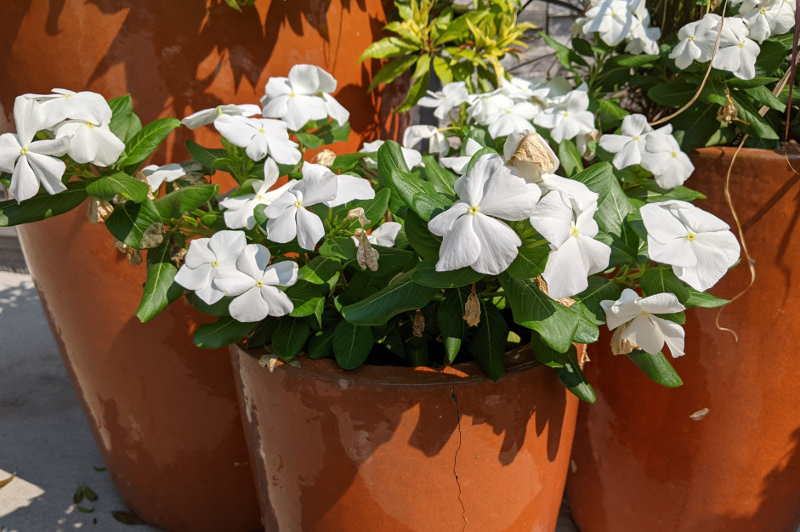Vinca is a genus of flowering plants in the family Apocynaceae, native to Europe, northwest Africa and southwest Asia. The English name periwinkle is shared with the related genus Catharanthus. Vinca (Catharanthus roseus) is a perennial in USDA zones 9 t0 11 but is grown as an annual in most regions. Foliage is dark green and shiny with five petal blooms.
This plant is available in many shades including red, purple, white, pink, and lavender. Some varieties have a light or dark pink center. Depending on the variety, Vincas grow 6-8 Inches tall with a width of 22-25 Inches. Thriving in full sun to partial shade, Vinca plants are great for garden borders, edging, ground cover or bedding plants, containers or window boxes.

Planting Vinca
Plant Vinca when evening temperatures are at least 60 degrees, typically in mid May. This plant is heat and drought tolerant and makes a great plant for warmer parts of a garden area. Plant Vinca in average soil in a full sun to partial shade location. Space the plants 12-15 inches apart. Water well after planting.
After that, weekly watering is all the plant needs. Mulch around the plants to help retain moisture. Use a general purpose fertilizer once or twice a season.
Watering Vinca
Vincas prefer their soil to be on the drier side. Water only when the top inch of soil is dry to the touch. Between rainfall and sprinklers, one inch of weather per week is recommended. Watering too much can be a common problem with Vincas. Water this plant early in the mornings to allow for the foliage to dry out during the day. This will help to prevent fungal disease and leaf spot.

Fertilizing Vinca
At planting time, apply compost to the soil or a slow-release fertilizer. After that, feed the plants once a month with a 10-10-10 nitrogen, phosphorous, potassium water-soluble fertilizer. Avoid using nitrogen rich fertilizers as this can produce too much leaf production with sparse flower production. Container grown Vinca will need more frequent feedings due to nutrients leaching from the soil as water drains. Water well after applying fertilizers.
Pruning Vinca
Vincas are a self-cleaning plant, which means that deadheading is not necessary. If you would like a fuller look to the plant, you can pinch the plant back. Pinching means to remove new growth at the tips of the branches so the plant does not become leggy.
Caring For Vinca in Pots
Vincas are great for raised beds, window boxes or containers. Use a well-draining potting soil. Be sure that the container has drainage holes, as wet soil can cause root rot. Vinca is drought tolerant. Water only when the top inch of soil feels dry. Space the plants far enough apart to allow for 8-12 inches of space at maturity. Place the container in an area that can get full sun to partial shade. Apply a liquid fertilizer twice a month, watering well after each application.

Winter Care for Vinca
Container Vincas can be brought indoors for the cold weather months. Be sure that your Vinca has a warm sunny place in the home. WAter only when the soil feels dry one inch down.
Vinca Plants For Sale
Common Vinca Care Questions
Do Vinca Flowers Spread?
Vinca does spread, sometimes aggressively once they're established, with no limits! The runners, where the nodes come into contact with the soil, will throw new roots.
Do Vincas Come Back Every Year?
There is are actually more than one type of vinca. Greater and Lesser Periwinkle (Vinca Major and Vinca Minor) are perennial. Catharanthus roseus is generally planted as an annual, to be replanted every year.
What Is The Growth Rate Of Vinca?
Vinca are a fast growing ground cover, and can cover a large area in one growing season.
Why Does Vinca Leaves Turning Brown?
Blight and leaf spot are common occurrences on vinca, and cause the leaves to first turn yellow, and eventually brown.
Do Vincas Like Sun Or Shade?
Vinca can thrive in full sun to partial shade, and can even be drought-tolerant though they do better with regular watering.
How To Keep Vinca From Getting Leggy?
Pinching off the tips of the stems can help create a bushier, more widely spreading plant and keep it from getting leggy.
What Are The Colors Of Vinca Flower?
Pinching off the tips of the stems can help create a bushier, more widely spreading plant and keep it from getting leggy.
Why Do Vinca Leaves Turn Yellow?
Vinca leaves can turn yellow from over-watering, and/or soil that does not drain well. A variety of fungal infections can also cause the leaves to yellow, as can improper fertilizing.
Have a question about Vinca? Fill out the form below and we will try and get back to your question as soon as possible. We may even feature your question on this article to help other gardeners!
 |
Author Chris Link - Published 08-03-2021 |
